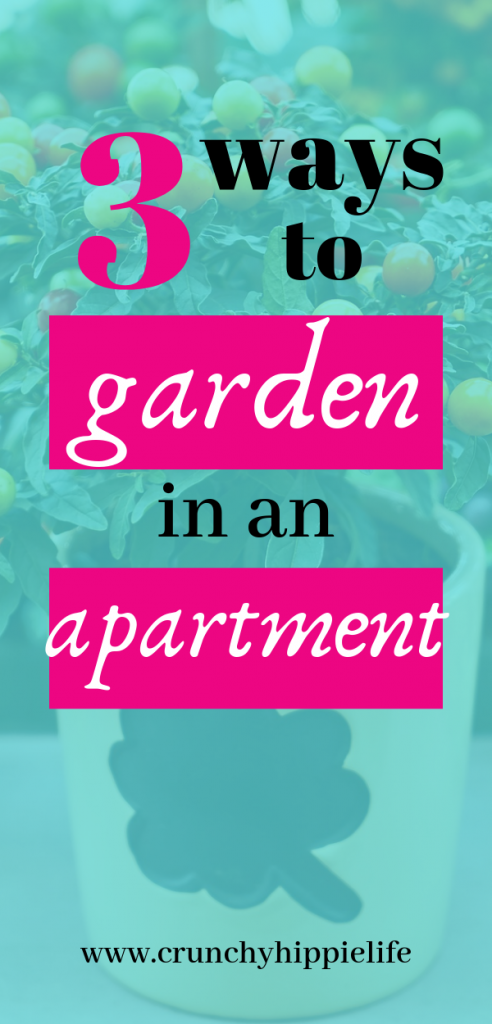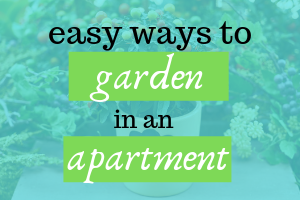This post may contain affiliate links, which means I receive a small portion of sales for compensation, at no cost to you. All opinions about any products and/or companies are entirely my own. Thank you for supporting Gentle Vine!
Some of my earliest memories are set in a garden. I remember riding in the wheelbarrow out to my grandpa’s garden and eating tomatoes fresh-off-the-vine like apples, and stuffing my little 5T overalls full of dirt-caked sweet potatoes. We had a garden in the backyard of the house I lived in growing up. Even in the townhouse, Peter helped me build and plant a garden in the tiny plot of dirt off the patio (before we were dating!). One thing that I knew was possible, but never did, was master how to grow a garden in an apartment.
RELATED: Gardening Essentials for Growing Your Food in a Small Space
So when my friend Sarah Howard said she was leading a group to teach on how to garden in an apartment, I begged her to write a post to share her knowledge with you all!
You’re definitely going to want to join her Facebook group to get an inside scoop and exclusive training. Just saying.
Now, let’s get to the good stuff and hear from Sarah!
How to Garden in an Apartment
So many people want to live a simpler, more self-sustainable life. They want to grow and/or raise their own food and become less reliant on the outside world. However, they feel stuck. They feel like they can’t do anything because of their current situation. They live in an apartment, have a tiny lot, or just don’t know where to begin.
Many people don’t realize they can grow their own food right where they’re at; even if they’re in an apartment or have a tiny lot.
My husband and I have felt the struggle with small space living. We’ve lived in an apartment with a tiny backyard as well as a house where there was hardly any space for growing veggies. We only had one spot that was 3’ x 20’ and another that was roughly 6’ 5’. With both locations, our initial thought was that we wouldn’t be able to do much. However, to our surprise (and relief) we were able to grow quite a bit using container gardening, vertical gardening, and raised beds.
How to Garden in Containers
Container gardening is one of the methods we have used for the last several years. And, it is one that we still use today. There are many different containers that you can use for your garden. We’ve used five-gallon buckets, mason jars, bottles, and the standard pots. One thing I love about container gardening is that if you don’t like where it’s located, all you have to do is pick up the container and move it. The trick is to figure out which one works best for what you’re trying to grow. You want to make sure that the width and depth are enough for your plant. For instance, spinach needs a wide container that’s at least 6-8 inches deep. Peppers require a larger container that’s at least 12” deep.
There are many different plants that thrive well in containers, here are just a few:
- Lettuce
- Tomatoes
- Peppers
- Radishes
- Spinach
- Strawberries
- Most herbs
How to Garden Vertically
Another method we’ve used to help save space is vertical gardening. Growing vertically allows you to fit more plants into a smaller space. It also increases your yield per square foot. We’ve used trellises in our garden and along the fence, poles in pots to help with those vining plants, and cages for some of our veggies like cucumber, beans, zucchini, and tomatoes. Like container gardening, vertical gardening doesn’t have to be fancy. We’ve used a couple of T-Posts with some chicken wire strung along for our beans. This year, we’re going to use cattle panels to make arch trellises. I’ve seen people simply put chicken wire or panels along their fence to help their plants grow upwards.
Vertical gardening saves lots of space because the plants grow up rather than spread out all over the garden. Not only does it save space, it also makes harvesting much easier, it makes pruning more convenient, and the chances of rot or pests is reduced.
How to Garden in Raised Beds
The third method we’ve used in our garden is raised beds. The main reason we’ve used raised beds is because of poor soil. We’ve lived in some areas where the soil is full of rocks and wasn’t good for planting. Raised beds are typically made from wood, but I’ve seen people use bricks for their beds. When using wood, be sure to get untreated wood. Some of the treated wood has chemicals in it that can seep into the soil. We’ve always used untreated cedar for our raised beds because it’s naturally water and rot resistant. Other types of wood that are good to use are Juniper, Black Locust, and Redwood. There are many benefits of raised beds such as better drainage, better weed control, and relief from roots from surrounding trees.
So, whether you’re in a studio apartment in a big city, out in the country with several acres of land, or somewhere in between – there is always a way for you to enjoy your own fresh home-grown veggies right where you are.
If you would like to learn more details on gardening in small places, come check out my free 3-day workshop, Gardening in Small Places, beginning Monday, March 11, 2019. I’ll be diving deeper into these three methods in my private Facebook group. Each day will be dedicated to one topic:
- Monday, March 11, 2019: Container Gardening
- Wednesday, March 13, 2019: Vertical Gardening
- Friday, March 15, 2019: Raised Beds
If this information was helpful for you, don’t forget to pin for future reference!



0 Comments